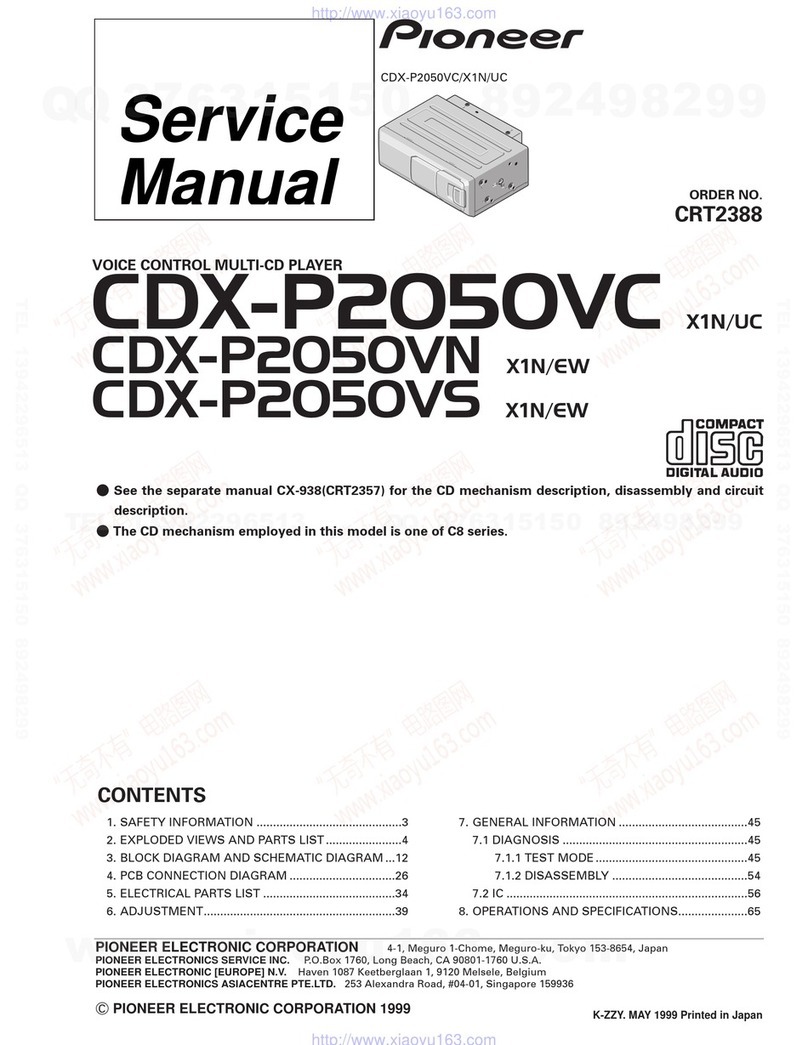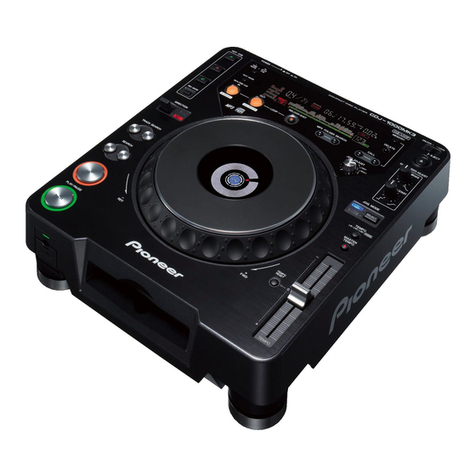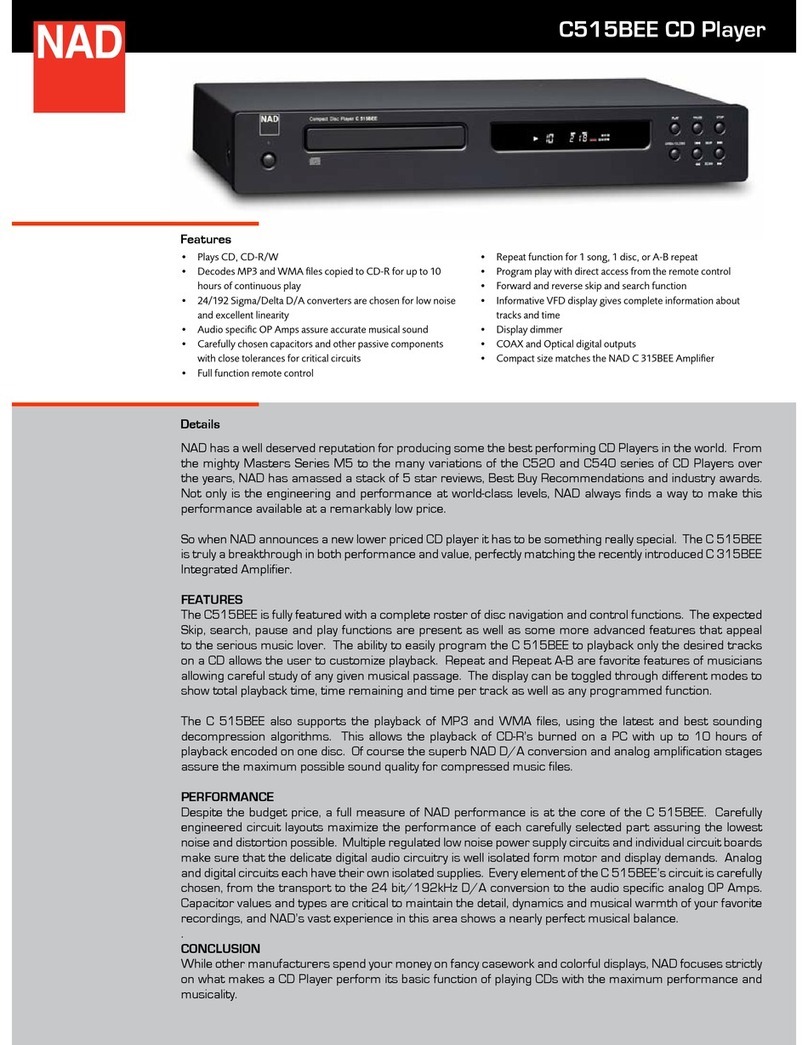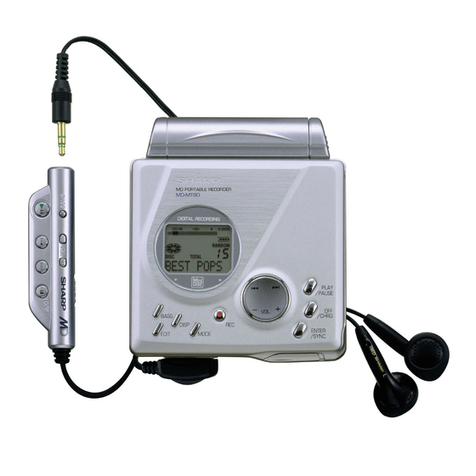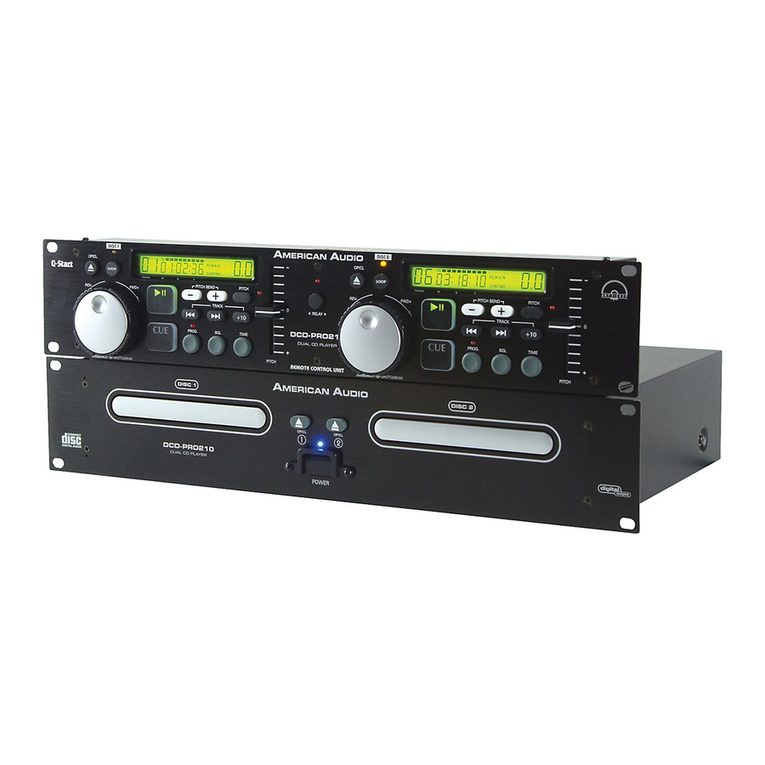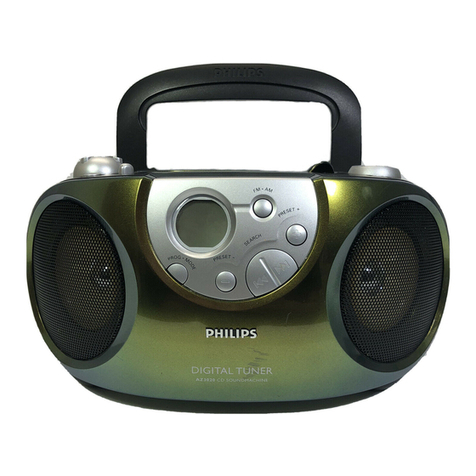Soulution SACD-Player 746 User manual

SACD-Player 746
User Manual
soulution
nature of sound


SACD-Player 746
User Manual
page 1
Dear client
We are proud that you decided yourself for a soulution SACD-Player 746. You have
acquired a SACD-Player with outstanding sonic performance which you will enjoy for
many years.
We understand your eagerness to get started but even though please study this
manual step by step before you integrate the SACD-Player 746 in your High Fidelity
system. This user manual contains also useful tips for the optimisation of your over-
all HiFi-System.
If there are any questions regarding the start-up or operation of your SACD-Player
746 please do not hesitate to contact your dealer.
Have fun!
Your soulution team

soulution
nature of sound
page 2
CE-Declaration of Conformity
Spemot AG declares that this product is in conformance with the following direc-
tives and standards:
Low Voltage Directive 2006/95/EG (EN/IEC 60065:2002)
Electromagnetic Compatibility 2004/108/EG (EN 55013:2001, EN 55020:2002,
EN 61000-3-2:2006, EN61000-3-3:1995)
FCC-Notice
Note: This equipment has been tested and found to comply with the limits for a
Class B digital device, pursuant to Part 15 of the FCC Rules. These limits are de-
signed to provide reasonable protection against harmful interference in a residential
installation. This equipment generates, uses and can radiate radio frequency energy
and, if not installed and used in accordance with the instructions, may cause harm-
ful interference to radio communications. However there is no guarantee that inter-
ference will not occur in a particular installation.
If this equipment does cause harmful interference to radio or television reception,
which can be determined by turning the equipment off and on, the user is encour-
aged to try to correct the interference by one or more of the following measures:
-adjust or relocate the receiving antenna
-increase the separation between the equipment and the receiver
-connect the equipment into a mains outlet on a circuit different from that to
which the receiver is connected
-consult the dealer or an experienced radio/TV technician for help
Disposal
According to the Directive 2002/96/EG of the European Parliament used
consumer-electro technical appliances have to be disposed separately
and have to be indicated with the following symbol.
In the case of disposal of this component please do so in conformity with legal and
environmental regulations.

SACD-Player 746
User Manual
page 3
Table of Content
1Technical Highlights......................................................................................4
2Safety advice: ...........................................................................................7
3Scope of delivery and packing ........................................................................8
4Rear panel of the External Power Supply 740PSU ...........................................8
5Rear panel of the SACD-Player 746 ..............................................................10
6Front panel of the SACD-Player 746 .............................................................12
7Programming ..............................................................................................16
8Remote control ...........................................................................................19
9Trouble shooting .........................................................................................20
10 Service .......................................................................................................20
11 Protection functions ....................................................................................21
12 Warranty.....................................................................................................21
13 Specifications .............................................................................................22
14 Dimension ..................................................................................................23
Quick start
Unpacking
ð
Unpack the
7
46 SACD
-
Player
ðStore the packing for future transportations
Treat the top class surface with care.
Positioning
ð
Position th
e
7
46 SACD
-
Player
on a stable base.
Cooling air must be able to escape unrestricted.
Cabling
ð
Disconnect all components of your setup from the mains
ðConnect the 746 with your (pre)amplifier
ðConnect the 746 with your digital source components
ðReconnect all components with the mains
While manipulating with cables the 746 SACD-Player
has to remain disconnected from the mains.
Programming
ð
Default values for all functions are programmed
.
ðNo additional settings are required.
Switch on
ð
Switch on
the
7
46 SACD
-
Player
ðSelect moderate volume at the (pre)amplifier of the 746
ðSwitch on the source components and your amplifier
Check the cabling before you switch on.

soulution
nature of sound
page 4
1Technical Highlights
1.1 Layout
The SACD-Player 746 has two housings, the Player itself and the External Power
Supply.
CD-Player: The analogue circuits are physically separated from
digital circuits. After the Sample-Rate-Converter unit the CD-Player is realized in
pure dual mono layout. Shields between the different sections of the CD-Player ef-
fectively reduce interferences between them.
External Power Supply: The power supplies are located in a separate, external
housing. This reduces potential interferences even further.
1.2 SACD/CD-mechanism
The SACD-Player 746 has a high quality SACD/CD-mechanism (Esoteric UMK-5). In
order to reduce errors from vibrations the drive is mounted on rubber damping ele-
ments.
1.3 DSP (Digital Signal Processor)
A powerful DSP performs the calculations for the upsampling to 24Bit, 384kHz.
The DSD data of a SACD is converted into PCM format during the upsampling pro-
cess. The converted data is extrapolated by a 3rd order polynomial algorithm. Addi-
tionally this DSP performs computations for the volume control and the balance set-
tings. Thanks to the 32Bit floating comma architecture of the DSP these calcula-
tions go without the usually increase of the quantification noise.
1.4
The SACD-Player 746 incorporates the unique and innovative, DSP based Zero-
Phase-Technology. Every digital to analogue converter requires an analogue low pass

SACD-Player 746
User Manual
page 5
filter in its output in order to suppress high frequency noise and aliasing signals,
which adds phase shifts for higher frequencies. Despite its relatively high cut-off
frequency of 120kHz, the analog 3rd order Bessel-filter of the 746 shows a phase
shift of up to 15° in the audio band. A powerful DSP does pre-correct these poten-
tial phase errors in the digital signal. Once the signal passes the D/A converter stag-
es and its related low pass filter these errors get cancelled out. The phase error of
the resulting analog music signal remains below 1°, 20Hz - 100kHz! The Zero-
Phase-Technology brings you even closer to the beauty of the source material!
1.5 Digital/Analogue-Converter (DAC)
The SACD-Player 746 has one DAC board per audio channel (left/right). We use the
Burr-Brown 1792 DAC which guarantees excellent performance. Only the top quali-
ty converter section which runs up to 384 kHz of the chip is used. The internal up
sampling section is bypassed!
The DACs are operated in dual mono mode. At the output of the converter chip four
current signals (I1+, I1-, I2+, I2-) are available. The four current signals are not
combined directly after the DAC but are first converted in a voltage signal and fil-
tered. The I-V converter runs up to 100 MHz fast. The summig of the voltage sig-
nals is done on the output-stage board.
The digital section of DAC board is supplied by the digital power supply unit; the
analogue section is supplied by the analogue power supply unit. This allows with-
holding noise present in the digital ground from the analogue section of the player.
1.6 Clock and PLL (Phase Lock Loop)
Utmost precision of the clock signal is a must have for a top class D/A-Conversion.
The clock unit of the SACD-Player 746 runs at a precision of < 0.01ppm.
For the synchronisation to external digital data the clock/PLL must adapt itself very
fast to eventual changes of the external data. This is done by a special digital clock
circuit that allows synchronising its clock signal very fast and at the same time ex-
tremely precise to the incoming signal.

soulution
nature of sound
page 6
1.7 Output stage
The output stage is optimised for velocity, precision and impulse current rating.
Thanks to its low output impedance of 2Wand Class-A operation (40mA idle cur-
rent) the output stage is stable on every load (also long cables are driven without
problems). The theoretical maximal current rating of 3 amperes is limited to 1 am-
pere. This is realised with a protection circuit outside the signal path.
The output stage is a completely symmetrical design. For optimal performance of
the unbalanced connection, the CD-Player has an additional unbalanced output sec-
tion. This ensures the same sonic quality for both connection types.
Due to the output stages bandwidth of up to 40 MHz (-3 dB) all details of the mu-
sic are reproduced naturally. The spatial reproduction gets really three dimensional
and holographic (optimal recording prerequisite). The power of the output stage en-
sures that all these details are truly transmitted to your (pre)amplifier. Cable losses
are minimised.
1.8 External Power Supply
The External Power Supply consists of three different power supply units which are
physically and electrically separated. Additionally the three units are separated by
the AC-Filter unit. Interferences between the different sections are minimized.
The supply voltages for the audio section are multi stabilised. We use an amplifier-
like circuit working into a capacitor. The ultra stable supply voltage has a load-
dependant deviation of 500 microvolt and a residual ripple < 0.01 microvolt. Solid
copper bars distribute the supply voltages across the D/A-Converter board and the
output stage.
The digital sections of the player require stable supply voltages alike. The supply
voltages for the digital Inputs / Outputs, the DSP/Clock board, the PLL as well as for
the digital section of the D/A-Converter are generated in a dedicated supply unit op-
timised for this function. The voltages are stabilised locally on the boards where
they are needed.
The drive of the SACD-Player 746 has its own dedicated power supply unit. This
guarantees that the drive can dispose over sufficient current when needed, at the
same time there is no interference between the drive and the rest of the SACD-
Player.

SACD-Player 746
User Manual
page 7
2Safety advice:
User manual
ð
Follow the safety advices
ðKeep this user manual.
Mains supply
Exclusively use 3 phase power cords with ground conductor.
Unplug the 746 from the mains in the following cases:
ðbefore you manipulate with cables
ðbefore cleaning
ðduring thunder storms
ðbefore you leave for longer periods
Cabling
While m
anipulating with cables the
746
has to remain disco
n-
nected from the mains. Wrong cabling may cause damages to
your 746, (pre)amplifier and loudspeakers. Excessive volumes
due to inappropriate handling may cause hearing damages.
Transport
Use only with
the cart, stand, tripod, bracket or table specified by
the manufacturer or sold with the apparatus. When a cart is used,
use caution when moving cart/apparatus combination to avoid
injury or tip over.
Packing
In order to omit condensation of water insi
de your
746
SACD
-
Player, let it warm up within the packing.
Please keep the original packing for future transports.
Operation
Never run your 746
SACD
-
Player
ðwith opened housing
ðwith closed cooling-slots
ðwith high ambient temperatures (>40°C)
ðclose to heat sources like radiators, etc.
ðwith extremely high humidity for example in humid cellars
ðclose to water (Sink, bathtub, or similar equipment)
Cleaning
Use a soft and dry towel. We suggest using a nonabrasive microf
i-
ber towel. Please do not use any solvents or liquidities
Service
Service by a qualified person required if
ðthe mains-cable or the mains connectors are damaged
ðforeign substances or liquidity have entered the 746
ðthe 746 has seen rain
ðthe 746 seems to malfunction
ðthe 746 has fallen to the floor or the housing is damaged

soulution
nature of sound
page 8
3Scope of delivery and packing
Please check the scope of delivery:
ðSACD-Player 746
ðExternal Power Supply 740PSU
ðRemote control (incl. batteries 2xAAA)
ðMains cable
ðDC-Analogue cable
ðDC-Digital cable
ðUser manual
ðCotton gloves
Please store the packing of the SACD-Player 746 and the external power supply
740PSU for future transports. Check your SACD-Player 746 and the External Power
Supply 740PSU for transport damages. In the case of damage, please contact your
soulution dealer.
If the
SACD
-
Player 746
and/or the External Power Supply 740PSU are still
very cold from the transport please let them warm up with
in the packing, in
order to omit condensation of water inside the units.
4Rear panel of the External Power Supply 740PSU
Rear panel of the External Power Supply 740PSU

SACD-Player 746
User Manual
page 9
4.1 DC- Connectors between External Power Supply and CD-Player (A,B)
Connect the DC-Analogue and the DC-Digital of the External Power Supply 740PSU
with enclosed high quality cables and the SACD-Player 746. Please secure the ca-
bles for tight fitting.
The External Power Supply 740PSU must be switched off while you are co
n-
necting the cables. The high current connectors could get damaged.
4.2 Mains (C)
Connect the External Power Supply 740PSU with the mains. The enclosed power
cord is optimised for this application.
After switch-on of the External Power Supply 740PSU the standby power supply
gets started. The display of the SACD-Player 746 shows "WAIT". As soon as con-
stant conditions are reached the SACD-Player 746 changes to operating condition
OFF (red LEDs in display).
Display after switch on of the mains Display in operating condition OFF
Only switch
-
off the mains connection if your
SACD
-
Player 746
is in operating
condition OFF.
4.3 Link (D)
With the LINK-connection the preamplifier soulution 720/721 can control the
switch-on of the SACD-Player 746. Connect the Master out 1 or Master out 2 of the
preamplifier 720/721 with the Slave-In of the External Power Supply 740PSU. The
Slave-out of the External Power Supply 740PSU allows connecting further soulution
components.

soulution
nature of sound
page 10
5Rear panel of the SACD-Player 746
Rear panel of the SACD-Player 746
5.1 Main-Out (E)
The SACD-Player 746 has symmetrical and asymmetrical connectors for the main
output signal. Connect the output terminals with your (pre)amplifier. Due to the ex-
traordinary load-stability of the output-stage there are no restrictions regarding the
selection of the connecting cables.
We recommend using symmetrical cables. For short cable lengths also asymmetrical
cables represent a high quality connection, top quality cable and optimal layout pre-
requisite.
Wrong cabling could dam
age your
SACD
-
Player 746
, your preamplifier, your
amplifier or your loudspeakers. Excessive volumes due to inappropriate han-
dling may cause hearing damages.
5.2 Digital-Output (F)
The SACD-Player 746 has 4 digital output connectors. (SPDIF 1 (RCA), SPDIF 2
(BNC), AES/EBU, Toslink). Connect your favourite digital output with the digital in-
put of your external D/A-Converter.
Wrong cabling could damage your
746
,
(
pre
)
amplifier
or
lou
d
speakers. E
x-
cessive volumes due to inappropriate handling may cause hearing damages.

SACD-Player 746
User Manual
page 11
5.3 Digital-Input (G)
The SACD-Player 746 has four digital input connectors (SPDIF 1 (RCA), SPDIF 2
(BNC), AES/EBU, Toslink).If you activate one of the digital inputs the display will
show the sampling frequency and the word length of the digital data.
Display for digital input signal at
SPDIF1 with 44.1 kHz
Display if the external DataStream is
interrupted
5.4 Clock-Output (H)
The high precision clock signal is available for the synchronisation of external digital
appliances at the clock-out terminal. Connect the clock out (BNC) with the clock
input terminals of your external component. The clock output of the SACD-Player
746 provides a word clock signal.
5.5 Clock-Input (I)
The SACD-Player 746 is able to receive Wordclock and Masterclock signals. For op-
timal adaptation to your clock generator the SACD-Player 746’s clock input can be
terminated with two different impedances.
5.6 RS232 –Interface (J)
The SACD-Player 746 can be remote controlled through the RS232 interface.
5.7 Type label (K)
The type label shows the serial number and the nominal power consumption.

soulution
nature of sound
page 12
6Front panel of the SACD-Player 746
Front panel of the SACD-Player 746
6.1 Power (L)
With the Power button you define the operating condition ON or OFF (red LEDs). In
operating condition OFF the audio circuits are completely disconnected from the
output terminal (Main-Out), the CD-drive and the digital sections remain deactivat-
ed. The Main-Out terminals are only activated if the SACD-Player 746 is ready for
operation and if no errors are present.
Display in operating condition OFF Display in operating condition
PROTECT ON
Display in operating condition ON
We suggest switching the SACD-Player 746 to operating condition OFF (power con-
sumption in < 0.5W) while not listening to music. Your SACD-Player 746 can easily
be activated with the remote control.
Sequence for switching of your SACD-Player 746: Operating conditions ON, OFF, Standby

SACD-Player 746
User Manual
page 13
LINK-System:
If you have connected the LINK –System, your soulution preamplifier will control
switch-on of the SACD-Player 746.
Unplug the External Power Supply 740PSU from the mains before you m
a-
nipulate with cables, before you clean your SACD-Player 746
, during thunder
storms or before you leave for longer periods. Before you switch off the mains
bring your SACD-Player 746 in operating condition OFF.
6.2 Open (M)
The Open button opens or closes the drawer of the SACD-Player 746. If a CD/SACD
is playing the first push on the Open button will stop the mechanism, the second
push will open the drawer.
Display while opening the mecha-
nism
Display while closing the mechanism Display while playing a CD/SACD
If the drawer and flap are hindered from closing by an object the mechanism will
open again.
Never close the drawer by hand. Do not try to block the flap from closing and
do not try to open it by hand.
6.3 Previous (N)
By tipping on the Previous button you can skip backwards through the tracks of the
CD/SACD. While pressing the Previous button permanently the SACD-Player 746
performs the fast backward function.

soulution
nature of sound
page 14
6.4 Play / Pause (O)
The Play/Pause button switches the SACD-Player 746 between play and pause
mode.
Display while playing a CD/SACD Display while the mechanism is in
pause.
6.5 Next (P)
By tipping on the Next button you can skip forward through the tracks of the CD.
While pressing the Next button permanently the SACD-Player 746 performs the fast
forward function.
6.6 Prog (Q)
The Prog button switches the SACD-Player 746 between operating-mode and pro-
gramming-mode. In the programming-mode you may adjust the SACD-Player to your
individual requirements.
6.7 Select (R)
The Select knob controls the functions Track select, Play/Pause, Open/Close and is
used for the Programming.
6.7.1 Track select
Rotating the Select knob allows selecting a new track. Rotating to the right will in-
crease the track number, rotating to the left will decrease the track number. After 3
seconds the newly selected track will be played.

SACD-Player 746
User Manual
page 15
6.7.2 Play/Pause
Pressing the Select knob for less than 0.5 seconds will switch the SACD-Player 746
between Play and Pause. If the drawer is open while pressing the Select knob for
less than 0.5 seconds the drawer will be closed and the SACD-Player 746 starts to
play track 1 of the inserted CD/SACD.
6.7.3 Open/Close
Pressing the Select knob for more than 0.5 seconds will Open or Close the drawer of
the SACD-Player 746. If a CD/SACD is playing while pressing the Select knob the
SACD-Player 746 is stopped and the drawer will be opened.
6.7.4 Programming:
In programming-mode the Select knob is used for the selection of the program-
functions and the function values.
6.8 Display / IR-Receiver (S)
The display shows all relevant information for operating your SACD-Player 746. In
operating mode the actual track, the playing time and the operating condition are
shown.
The IR
-
receiver for the remote control is located in the lower left corner b
e-
hind the display glass. For best reception do not place any objects in fron
t of
the display.
Never place your SACD-
Player 746 on the front panel. The display glass
could get scratched or even burst.

soulution
nature of sound
page 16
7Programming
7.1 Overview
The available Program-functions allow adjusting the SACD-Player 746 to your indi-
vidual High-Fidelity set-up.
Push on the Prog button switches the SACD-Player 746
between operating-mode and programming-mode.
Timeout after 10 seconds.
Rotating of the Select knob allows selecting the desired
Program-Function
Push on the Select knob for approval of the selected
function. Now the value domain of the selected Program-
Function is active. (red LEDs in display).
Rotating of the Select knob allows for adjusting the de-
sired value.
Push on the Select knob for approval of the respective
value.

SACD-Player 746
User Manual
page 17
7.2 Program-Functions
Function
Values
Remarks
NORM
,
LINK
NORM
ð
OFF (Standby)
LINK ðDepending on Link System
TRCK
-
FWD
,
TRCK-BWD,
DISC-FWD
DISC-BWD
TRCK
-
FWD
= Track
time forward
TRCK-BWD = Track time backward
DISC-FWD = Disc time forward
DISC-BWD = Disc time backward
Trac
k,
Disc,
Random, OFF
Defines
r
epeat
mode
.
0°
,
180°
0°
= no inversion
180° = left & right inverted
ON
,
OFF
(De)activates the SPDIF 1 output
ON
,
OFF
(De)activates the SPDIF
2
output
ON
,
OFF
(De)activates the
A
ES
-
EBU
output

soulution
nature of sound
page 18
Function
Value
Remarks
ON
,
OFF
(De)activates the
O
ptical
output
CD
,
R
CA, BNC,
AES/EBU,
Toslink
D
efines
the
input
CD
,
SPDIF 1
,
SPDIF 2,
AES/EBU,
Toslink, OFF
D
efines which data shall be a
vailable at
the digital outputs
ON
,
OFF
Defines the Surround
-
IN.
Volume and balance settings get ig-
nored for this input.
ON
-
300
,
ON
-
75
,
OFF
ON
-
300
=
300 ohm
ON-75 = 75 ohm
1 = low
2 = medium
3 = high
Sets the brightness of the display
Loads
the default values
(bold)
for all
functions.
Table of contents
Other Soulution CD Player manuals




